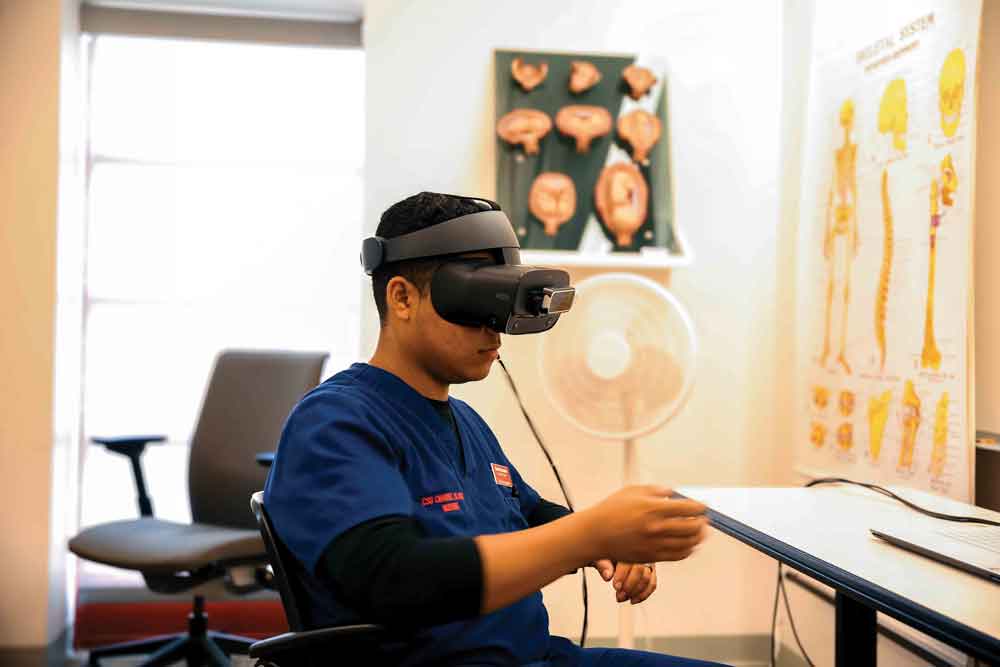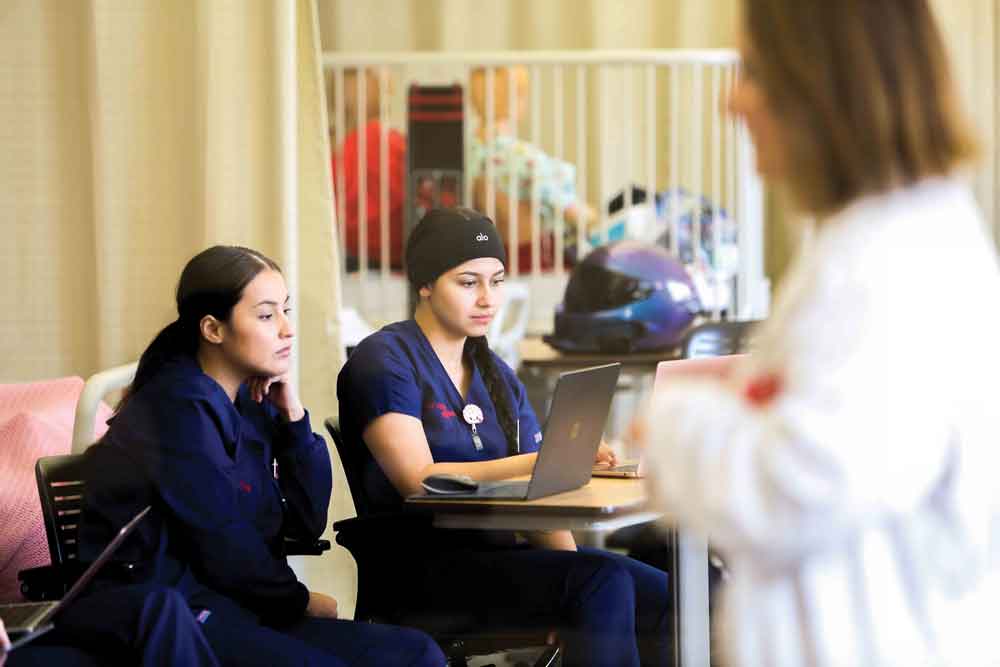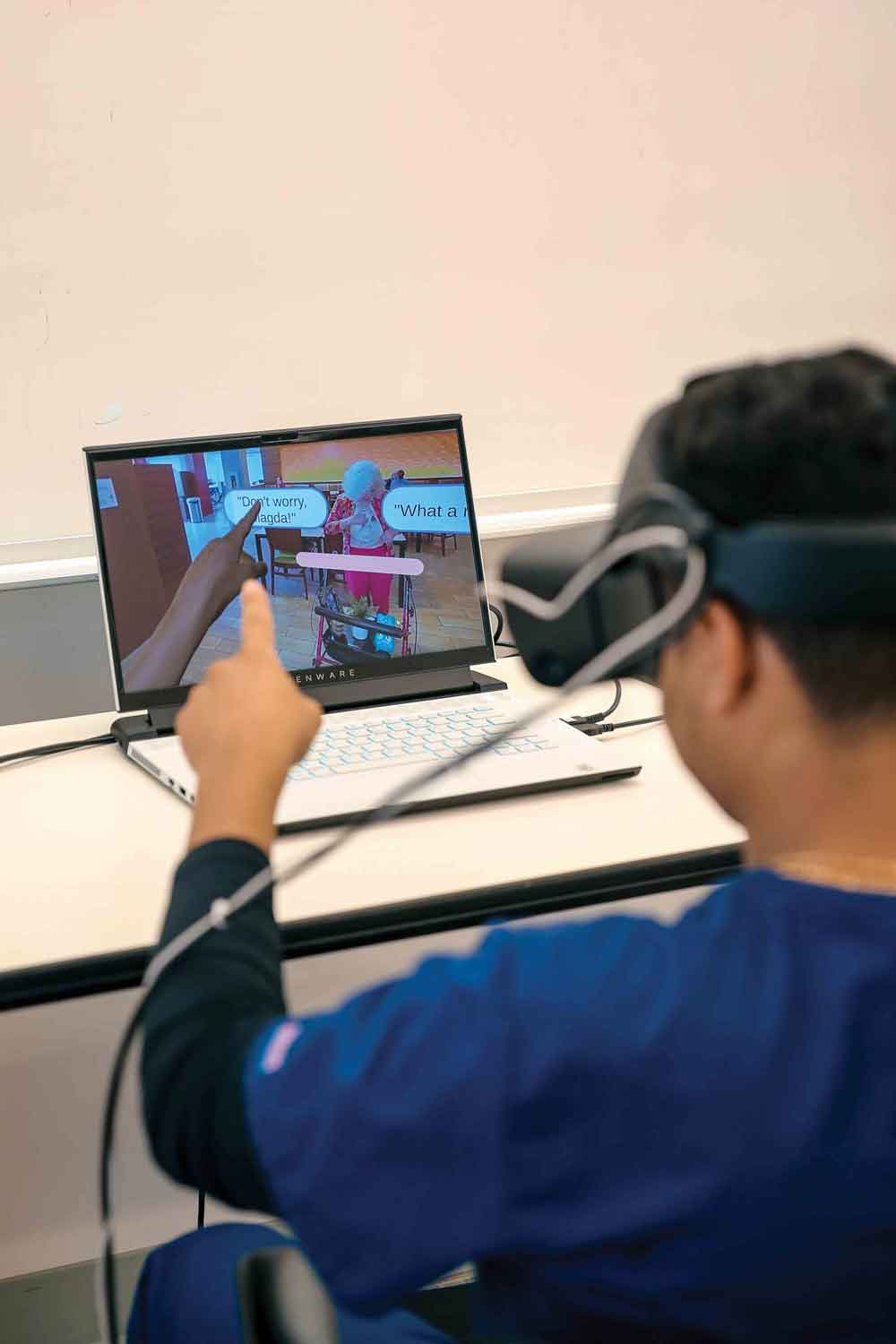 A nurse encounters a virtual patient in a VR simulation.
A nurse encounters a virtual patient in a VR simulation.
Once CSUCI Nursing students strap on a virtual reality (VR) headset and become a man named Hector navigating his first days as a caregiver in a long-term care facility, they never walk into a hospital room the same way.
“They go into the patients’ rooms in clinicals like, ‛Hello, Mr. Smith, I’m your Nursing student today. Can I get you some water? Can I do this?’ rather than, ‛Hi, I’m your student nurse. Bye,’” said Assistant Professor of Nursing Julia Chang.
VR — an interactive, three-dimensional, computer-generated simulation — is used in many ways at CSUCI. Students are learning with the help of VR, acquiring the skills to create the simulations and researching their effective uses.
CSUCI became one of the first Nursing programs in the country to use Embodied Labs’ VR scenarios in 2019 after piloting the technology, and CSUCI's Health Science program followed suit. Students experience being a man as he learns he has terminal lung cancer, transitions to hospice care and dies. They also become a veteran experiencing post-traumatic stress disorder and a trans woman in defining moments of her life.
Along the way, the Nursing and Health Science students learn about diseases and how to communicate with patients and their family members. Most of all, they learn compassion and empathy.
“I think it is really difficult to teach empathy in a classroom setting. You have to experience it,” Chang said.
Experiencing being a man dealing with macular degeneration and hearing loss changed how Health Science and Biology alumna Susie Choe ’22 views people with a variety of challenges.
 Nursing technology is quickly accelerating.
Nursing technology is quickly accelerating.
“It truly opened my eyes to what our older generations must be going through and the difficulties they face when diagnosed with a medical condition,” said Choe, a patient care coordinator planning to apply for medical school.
Research findings on use of VR in preparing nurses show substantial gains in knowledge, confidence and empathy. Associate Professor of Health Science Kristen Linton and her Research Methods students found the same improvements in their own studies.
“Virtual reality is immersive in the feeling of being there and it happening to you makes you think and understand more about the diseases. Students can actually interact and feel the emotions rather than just viewing and choosing some answers,” CSUCI Nursing Simulation Lab Technician Saijal Kapadia said.
“VR offers a unique platform for accessibility and
amplifying underrepresented voices.”
—Simon Quiroz
In a mixed-reality simulation where Nursing students wear headsets and talk to avatars on a big screen voiced by actors in real time, they get to practice difficult conversations.
“We tell the students, ‛This is a safe space. You are meant to make mistakes. You’re meant to learn. And we want to see how you react if you do make a mistake in a clinical situation. We want you to get that experience,’” Chang said.
After VR, students have time to process what they experienced. This can help them learn to protect themselves in a very emotional job.
“Having the end-of-life scenario VR experience is probably one of the best things they can do prior to experiencing a patient death on a unit,” Chang said.
While Chang is expanding the use of VR in Nursing, Assistant Professor of Art Simon Quiroz is integrating it into CSUCI's film courses. A pioneer in the field, he is teaching students in introductory film and video production courses about volumetric storytelling, which emphasizes spatial composition to foster a deeper understanding of audience engagement, empathy and immersion. This prepares them for creating immersive VR.
 VR also is being incorporated into the proposed bachelor’s degree in Cinema and Creative Media Arts scheduled to launch in 2025.
VR also is being incorporated into the proposed bachelor’s degree in Cinema and Creative Media Arts scheduled to launch in 2025.
“The relevance of mastering VR concepts is undeniable,” Quiroz said.
One of the valuable aspects of VR is that it allows someone to experience people of various ethnicities, identities and backgrounds. That helps Nursing and Health Science students develop cultural sensitivity and Art students tell more stories through filming.
“VR offers a unique platform for accessibility and amplifying underrepresented voices,” Quiroz said.
Linton wondered whether VR also could be used to treat people with brain injuries. With guidance from Assistant Professor of Mechatronics Engineering Bahareh Abbasi, CSUCI's Computer Science students created one VR scenario that asked patients from the Brain Injury Center of Ventura County to follow a red ball and another where they needed to remember who wants which items tossed to them.
Health Science students, mentored by Linton and Health Science Lecturer Melissa Gutierrez-Jimenez, collected data. They found the VR sessions improved eye-tracking in 75% of patients with mild and moderate brain injuries and memory in 66%. Ventura County Medical Center is now planning a pilot study on the eye-tracking scenario for patients hospitalized with severe traumatic brain injury.
“I’m very excited about the possibilities,” Linton said.
For Health Science major Savanna Monson, studying the effectiveness of the Alzheimer’s scenario in her Research Methods class sparked her interest in the disease and research. She joined the brain injury research team and now is applying to doctoral programs where she can study neurodegeneration.
“This was a turning point for me,” Monson said.
